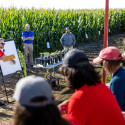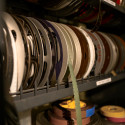Vet school faculty, staff help Katrina’s lost pets
While most people watched in horror as news details of Hurricane Katrina unfolded and perhaps donated money to the rescue efforts, a few dedicated souls traveled south to help.
They brought back tales of destruction, along with numerous animals that needed foster care or adoptive homes, opening the doors for folks back home to help, too. And from personal experience, they know which groups are still out in the trenches, helping with ongoing recovery efforts and still in need of donations.
“I was so appalled that people had to choose between their pets and safety,” says Sandra Colrud, a veterinary technician with the UW–Madison School of Veterinary Medicine who made the trip south.
Colrud and two other veterinary technicians from the school, Robin Sereno and Tracie Melahn, used vacation time to volunteer for the animal rescue efforts in the hurricane’s aftermath. They were dispatched to St. Bernard’s Parish, about two miles from the New Orleans French Quarter. Tracey Hageny, a veterinary medical student, arranged the timing of her trip so that she wouldn’t miss any exams. She helped at an animal shelter in Hattiesburg, Miss.
Joe Foerner, an adjunct large-animal surgeon at the school, drove to Louisiana five days after Hurricane Katrina with 22,000 pounds of supplies loaded into two horse trailers. He was responding to a colleague who informed him the hurricane left him with no equipment, and so many animals. “They had nothing,” Foerner says.
All were shocked at the amount of devastation they saw.
“There was caked mud over everything,” says Sereno. “We were working near the oil refineries. We were seeing a lot of animals with chemical burns on their foot pads from the chemicals and pollution. I’m not sure what toxins were in that mud, but I threw my clothes away afterwards.”
The veterinary medical school volunteers worked for organizations that were overseeing the animal rescue efforts, including the Humane Society of the United States, the Rural Area Veterinary Services and the American Society for the Prevention of Cruelty to Animals.
They brought back tales of roaming animals fighting each other for food. Temporary shelters, supplemented by donated pet crates, served as holding pens. Volunteers scoured damaged homes and attempted to capture the frightened, disoriented animals they found.
“I had to turn off emotionally,” Hageny says. “If I got bogged down in individual animals, I would have been a blubbering mess.”
The need continues. Animal rescue groups continue their work in the area, and many animals still need homes because their former owners are no longer able to care for them. Hageny and Sereno relocated some of the animals to Madison.
Sereno would love to find a good home for Beauregard, a black Labrador retriever mix. She brought him back because he needed special nursing care for severe bite wounds on his hind legs from another dog.
She also recommends that individuals interested in helping visit the Web sites of organizations that are still on location: The Mutt Shack and St. Bernard Parish Animal Control. She plans to return to Louisiana to provide additional help in January.
If you would like to help, visit the Web sites suggested by Sereno, or the Web site of the Shelter from the Storm animal rescue group represented by Hageny. Many Katrina cats, especially, need homes.
Other ways to help include donating air miles so more experienced personnel can be brought on location to help rescue the remaining animals; donate to help rebuild the destroyed St. Bernard Parish animal shelter; or donate funds to help with spaying/neutering, immunizing, and medical assistance through Shelter From the Storm.




